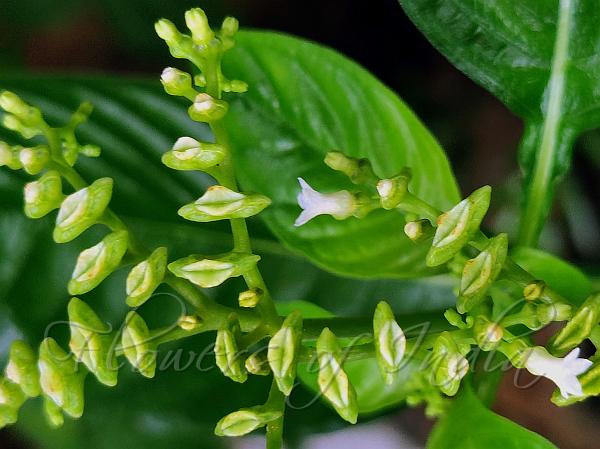|
| Mongoose Plant |
|

|

| File size | 787733 |
| Original date | 9/30/23 10:13 AM |
| Resolution | 0 x 0 |
| Flash | Flash did not fire, auto |
| Focal length | 6.064mm |
| Exposure time | 1/100s |
| Aperture | 1.88 |
| Focus Distance | |
| Metering Mode | Center weighted average |
| Camera make | OnePlus |
| Camera model | OnePlus 9 5G |
| Sensor type | Undefined |
|
|
|
|
Photo: |
Botanical name: Ophiorrhiza mungos Family: Rubiaceae (Coffee family)
Synonyms: Ophiorrhiza ostindica
Synonyms: Ophiorrhiza ostindica
Mongoose Plant is an annual erect herb, rooting at
lower nodes. The species name is based on the folklore that mongoose
eat this plant when bitten by a snake. Leaves are 7-15 x 3-6 cm,
elliptic or elliptic-lanceshaped, base narrowed, tip tapering, papery,
hairy on veins below. Leaf-stalks are up to 1.5 cm, stipules
sharp-tipped, 3-5 mm long, 2-fid at tip. Flowers are borne at
branch-ends, in branched, scorpion-like cymes, dense.
Flower-cluster-stalks are up to 2.5 cm long, rusty velvet-hairy.
Sepal-tube is about 1 mm long; sepals obscure. Flowers are 0.8-1 cm
long, white with pink shades on petals. Capsules are 2.5-3 long, 4-6 mm
wide, inverted-heart-shaped, laterally compressed, hairless, seeds
many, angular. Mongoose Plant is found in India, Bangladesh, East
Himalaya, Jawa, Malaya, Myanmar, Nicobar Is., Sri Lanka, Sumatera,
Thailand, Vietnam. Flowering: August-October.
Medicinal uses: In India, the bitter root of
Mongoose Plant is used as an antidote for snake bites. Some scientists
contest the anti-snake-bite properties of the plant. They believe that
this misconception seems to be based on its resemblance to Rauvolfia
serpentina.
In India, the bitter root of
Mongoose Plant is used as an antidote for snake bites. Some scientists
contest the anti-snake-bite properties of the plant. They believe that
this misconception seems to be based on its resemblance to Rauvolfia
serpentina.
Medicinal uses:
 In India, the bitter root of
Mongoose Plant is used as an antidote for snake bites. Some scientists
contest the anti-snake-bite properties of the plant. They believe that
this misconception seems to be based on its resemblance to Rauvolfia
serpentina.
In India, the bitter root of
Mongoose Plant is used as an antidote for snake bites. Some scientists
contest the anti-snake-bite properties of the plant. They believe that
this misconception seems to be based on its resemblance to Rauvolfia
serpentina. | Identification credit: Preetha P.S. | Photographed in Palode, Thiruvananthapuram , Kerala. |
• Is this flower misidentified? If yes,